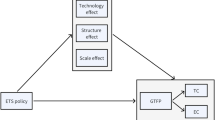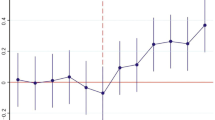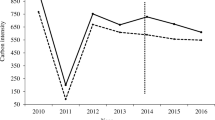Abstract
Carbon emission trading has been actively applied in many countries, and its operational effect has received widespread attention. However, previous studies mostly focused on single environmental effect, and the investigation of the comprehensive environmental effect needs to be further supplemented. Based on this, this paper explores the comprehensive environmental effect of carbon emission trading with eco-efficiency as the starting point. First, this paper measures eco-efficiency using the super-efficient minimum distance to strong efficient frontier (MinDS) model with undesirable outputs. Second, this paper uses the propensity score matching difference in difference (PSM-DID) model to quantify the effect of carbon emission trading on eco-efficiency. Finally, this paper examines the mediating mechanism of the effect of carbon emission trading on eco-efficiency based on the mediating effect model. The results show that carbon emission trading can improve the level of urban eco-efficiency. Energy savings and increased efficiency effectively mediate the promoting effect of carbon emission trading on eco-efficiency. The mediating push effect of R&D innovation and industrial structure restructuring has not yet appeared. This paper can not only provide policy basis for the improvement of carbon emission trading market but also provide reference for the construction of carbon emission trading market in developing countries.
Graphical abstract



Similar content being viewed by others
Data availability
The datasets used and analyzed during the current study are available from the corresponding author on reasonable request.
Notes
The 27 experimental cities are Beijing, Tianjin, Shanghai, Chongqing, Guangzhou, Shaoguan, Shenzhen, Foshan, Jiangmen, Zhanjiang, Maoming, Zhaoqing, Meizhou, Yangjiang, Qingyuan, Dongguan, Zhongshan, Chaozhou, Wuhan, Huangshi, Yichang, Ezhou, Jingmen, Xiaogan, Huanggang, Xianning, and Suizhou. Due to space limitation, this article only lists the pilot cities, and nonpilot cities will not be listed one by one.
References
Abadie A, Imbens GW (2006) Large sample properties of matching estimators for average treatment effects. Econometrica 74(1):235–267. https://doi.org/10.1111/j.1468-0262.2006.00655.x
Aparicio J, Ruiz JL, Sirvent I (2007) Closest targets and minimum distance to the Pareto-efficient frontier in DEA. J Prod Anal 28(3):209–218. https://doi.org/10.1007/s11123-007-0039-5
Cai WG, Ye PY (2021) Does carbon emission trading improve low-carbon technical efficiency? Evidence from China. SUSTAINABLE PRODUCTION AND CONSUMPTION 29:46–56. https://doi.org/10.1016/j.spc.2021.09.024
Chen Q (2014) Advanced econometrics and Stata application, 2nd edn. Higher Education Press, Beijing
Chen YT, Feng J (2020) Do corporate green investments improve environmental performance? Evidence from the perspective of efficiency. Account Res 01:179–192
Chen L, Wu HJ (2015) Research status and potential problems of differences-in-differences method in China. J Quant Tech Econ 32(07):133–148
Chen MX, Xian Y, Wang PL, Ding ZJ (2021b) Climate change and multi-dimensional sustainable urbanization. Acta Geogr Sin 76(08):1895–1909
Chen S, Shi AN, Wang X (2020) Carbon emission curbing effects and influencing mechanisms of China’s Emission Trading Scheme: the mediating roles of technique effect, composition effect and allocation effect. J Clean Prod. 264. https://doi.org/10.1016/j.jclepro.2020.121700
Chen L, Liu YN, Gao Y, Wang JJ (2021a). Carbon emission trading policy and carbon emission efficiency: an empirical analysis of China’s prefecture-level cities. Front Energy Res. 9. https://doi.org/10.3389/fenrg.2021a.793601
Chen Z, Song P, Wang BL (2021c) Carbon emissions trading scheme, energy efficiency and rebound effect - evidence from China’s provincial data. Energy Policy. 157. https://doi.org/10.1016/j.enpol.2021c.112507
Chen ZF, Zhang X, Chen FL (2021d) Do carbon emission trading schemes stimulate green innovation in enterprises? Evidence from China.Technol Forecast Soc Chang 168. https://doi.org/10.1016/j.techfore.2021d.120744
Cheng G (2014) Data envelopment analysis: methods and MaxDEA software, 1st edn. Intellectual Property Press, Beijing
Cui XY, Zhao T, Wang J (2021) Allocation of carbon emission quotas in China’s provincial power sector based on entropy method and ZSG-DEA. J Clean Prod. 284. https://doi.org/10.1016/j.jclepro.2020.124683
Dong ZQ, Wang H (2021) Validation of market-based environmental policies: empirical evidence from the perspective of carbon emission trading policies. Stat Res. 38(10):48–61. https://doi.org/10.19343/j.cnki.11-1302/c.2021.10.005
Fan Y, Wu J, Xia Y, Liu JY (2016) How will a nationwide carbon market affect regional economies and efficiency of CO2 emission reduction in China? China Econ Rev 38:151–166. https://doi.org/10.1016/j.chieco.2015.12.011
Fan QQ, Liang MJ, Qiao YB (2021) On the factor payments and the regional reallocation mechanism of carbon emissions permits. Finan Trade Econ 42(11):101–115
Gao YN, Li M, Xue JJ, Liu Y (2020) Evaluation of effectiveness of China’s carbon emissions trading scheme in carbon mitigation. Energy Economics, 90. https://doi.org/10.1016/j.eneco.2020.104872
Geng WX, Fan Y (2021) Does a carbon trading policy contribute to energy intensity reduction? -Evidence from the Hubei carbon trading pilot. China Popul Resour Environ 31(09):104–113
Han HB, Zhang XY (2020) Static and dynamic cultivated land use efficiency in China: a minimum distance to strong efficient frontier approach. J Clean Prod. 246. https://doi.org/10.1016/j.jclepro.2019.119002
Hu J, Hunag N, Shen HT (2020a) Can market - incentive environmental regulation promote corporate innovation? A natural experiment based on China’s carbon emissions trading mechanism. Journal of Financial Research 01:171–189
Hu YC, Ren SG, Wang YJ, Chen XH (2020b) Can carbon emission trading scheme achieve energy conservation and emission reduction? Evidence from the industrial sector in China.Energy Economics. 85. https://doi.org/10.1016/j.eneco.2019.104590
Huang JH, Yang XG, Cheng G, Wang SY (2014) A comprehensive eco-efficiency model and dynamics of regional eco-efficiency in China. J Clean Prod 67:228–238. https://doi.org/10.1016/j.jclepro.2013.12.003
Lan H, Chen YH (2022) Development and system construction of carbon trading market. Reform 01:57–67
Lei YT, Zhang X, Peng WX (2022). Can China’s policy of carbon emissions trading optimize manufacturing structure? Evidence from Guangdong based on a synthetic control approach. SUSTAINABILITY. 14(6). https://doi.org/10.3390/su14063302
Li Z, Li GP (2010) A study on the regional difference of Chinese urban energy efficiency and its influential factors. Econ Theory Bus Manag 07:17–23. https://doi.org/10.3969/j.issn.1000-596X.2010.07.003
Li J, Wang SY, Fan J, Zhao DT (2016) Study on the effect of personal carbon trading scheme on consumers’ energy consumption. Systems Engineering-Theory & Practice 36(01):77–85
Li W, Zhang YW, Lu C (2018) The impact on electric power industry under the implementation of national carbon trading market in China: a dynamic CGE analysis. J Clean Prod 200:511–523. https://doi.org/10.1016/j.jclepro.2018.07.325
Li X, Hu ZG, Cao JH (2021a) The impact of carbon market pilots on air pollution: evidence from China. Environ Sci Pollut Res 28(44):62274–62291. https://doi.org/10.1007/s11356-021-14995-z
Li ZY, Zhao T, Wang J, Cui XY (2021b) Two-step allocation of CO2 emission quotas in China based on multi-principles: going regional to provincial. J Clean Prod. 305. https://doi.org/10.1016/j.jclepro.2021b.127173
Lin BQ, Jia ZJ (2019) What will China’s carbon emission trading market affect with only electricity sector involvement? A CGE Based Study Energy Economics 78:301–311. https://doi.org/10.1016/j.eneco.2018.11.030
Liu Y, Tan XJ, Yu Y, Qi SZ (2017) Assessment of impacts of Hubei Pilot emission trading schemes in China – a CGE-analysis using TermCO2 model. Appl Energy 189:762–769. https://doi.org/10.1016/j.apenergy.2016.05.085
Liu YW, Ouyang Y, Cai HY (2021) Evaluation of China’s agricultural green TFP and its spatiotemporal evolution characteristics. J Quant Tech Econ 38(05):39–56. https://doi.org/10.13653/j.cnki.jqte.2021.05.003
Liu ZL, Sun HB (2021) Assessing the impact of emissions trading scheme on low-carbon technological innovation: evidence from China. Environ Impact Assess Rev. 89. https://doi.org/10.1016/j.eiar.2021.106589
LiuY, Zhang XC (2017) Carbon emission trading system and enterprise R&D innovation: an empirical study based on triple difference model. Econ Sci. (03):102–114. https://doi.org/10.19523/j.jjkx.2017.03.008
Liu JY, Zhang YJ (2021) Has carbon emissions trading system promoted non-fossil energy development in China? Appl Energy 302. https://doi.org/10.1016/j.apenergy.2021.117613
Liu YQ, Liu S, Shao XY, He YQ (2021a) Policy spillover effect and action mechanism for environmental rights trading on green innovation: evidence from China’s carbon emissions trading policy. Renew Sustain Energy Rev, 153. https://doi.org/10.1016/j.rser.2021a.111779
Lu M, Wang Y, Wang X (2021) Impact of China carbon emissions trading mechanism on industrial competitiveness: evidence from Beijing IOP Conference Series-Earth and Environmental Science, 657. https://doi.org/10.1088/1755-1315/657/1/012105
Ma XJ, Li YD, Wang CX, Yu YB (2018) Ecological efficiency in the development of circular economy of China under hard constraints based on an optimal super efficiency SBM-Malmquist-Tobit model. Chin Environ Sci 38(09):3584–3593. https://doi.org/10.19674/j.cnki.issn1000-6923.2018.0387
Ma XJ, Chen RM, Dong BY, Niu XQ (2019) Factor decomposition and decoupling effect of China’s industrial carbon emissions. Chin Environ Sci 39(08):3549–3557. https://doi.org/10.19674/j.cnki.issn1000-6923.2019.0421
Ma Q, Yan G, Ren XH, Ren XS (2022) Can China’s carbon emissions trading scheme achieve a double dividend? Environ Sci Pollut Res. https://doi.org/10.1007/s11356-022-19453-y
Nie X, Wu JX, Chen ZP, Zhang AL, Wang H (2021) Can environmental regulation stimulate the regional Porter effect? Double test from quasi-experiment and dynamic panel data models. J Clean Prod 314. https://doi.org/10.1016/j.jclepro.2021.128027
Nie X, Chen ZP, Wang H, Wu JX, Wu XY, Lu B, Qiu L, Li YY (2022) Is the “pollution haven hypothesis” valid for China’s carbon trading system? A re-examination based on inter-provincial carbon emission transfer. Environ Sci Pollut Res. https://doi.org/10.1007/s11356-022-18737-7
Peng HR, Qi SZ, Cui JB (2021) The environmental and economic effects of the carbon emissions trading scheme in China: the role of alternative allowance allocation. Sustain Prod Consum 28:105–115. https://doi.org/10.1016/j.spc.2021.03.031
Qi SZ, Lin S, Cui JB (2018) Do environmental rights trading schemes induce green innovation? Evidence from listed firms in China. Econ Res J 53(12):129–143
Qi SZ, Zhang ZY (2019) EU ETS, EUA Allocation and renewable energy technological innovation. World Economy Studies. (09):119–133+136. https://doi.org/10.13516/j.cnki.wes.2019.09.009
Qian XS, Kang J, Tang YL, Cao XP (2018) Industrial policy, efficiency of capital allocation and firm's total factor productivity——evidence from a natural experiment in China. China Industrial Economics (08):42–59.https://doi.org/10.19581/j.cnki.ciejournal.2018.08.003
Rasche R, Tatom J (1977) Energy resources and potential GNP. Federal Reserve Bank of St Louis 59:10–24
Ren YY, Fu JY (2019) Research on the effect of carbon emissions trading on emission reduction and green development. China Popul Resour Environ 29(05):11–20
Schaltegger S, Sturm A (1990) Ökologische Rationalität: Ansatzpunkte zur Ausgestaltung von ökologieorientierten Management instrumenten. Die Unternehmung 44(4):273–290
Shao S, Fan MT, Yang LL (2022) Economic restructuring, green technical progress, and low-carbon transition development in China: an empirical investigation based on the overall technology frontier and spatial spillover effect. Management World. 38(02):46–69+4–10. https://doi.org/10.19744/j.cnki.11-1235/f.2022.0031
Shi JR, Cai HL, Tang L, Yu LA (2015) Impacts of carbon emission trading on China: based on CGE model. Chinese J Manag Sci 23(S1):801–806
Song DY, Zhu WB, Wang BB (2021) Micro-empirical evidence based on China’s carbon trading companies: carbon emissions trading, quota allocation methods and corporate green innovation. China Popul Resour Environ 31(01):37–47
Song XL, Kong CM (2018) An empirical analysis of the impact of China’s carbon trading market on regional economic structure. Macroeconomics. (09):98–108. https://doi.org/10.16304/j.cnki.11-3952/f.2018.09.009
Tan XJ, Sun Q, Wang MJ, Cheong TS, Shum WY, Huang JP (2022) Assessing the effects of emissions trading systems on energy consumption and energy mix. Appl Energy. 310. https://doi.org/10.1016/j.apenergy.2022.118583
Tang K, Liu YC, Zhou D, Qiu Y (2021a) Urban carbon emission intensity under emission trading system in a developing economy: evidence from 273 Chinese cities. Environ Sci Pollut Res 28(5):5168–5179. https://doi.org/10.1007/s11356-020-10785-1
Tang K, Zhou Y, Liang XY, Zhou D (2021b) The effectiveness and heterogeneity of carbon emissions trading scheme in China. Environ Sci Pollut Res 28(14):17306–17318. https://doi.org/10.1007/s11356-020-12182-0
Wan L, Wang SY, Zang JN, Zheng QQ, Fang WP (2021) Does the EU emissions trading system help reduce PM2.5 damage? A research based on PSM-DID method. Environ Sci Pollut Res 29(16):23129–23143. https://doi.org/10.1007/s11356-021-17640-x
Wang WJ, Chen ZL (2019) A study on the initial carbon quota allocation scheme for provincial regions in China - based on the perspective of responsibility and target, equity and efficiency. Management World. 35(03):81–98. https://doi.org/10.19744/j.cnki.11-1235/f.2019.0036
Wang M, Zhou P (2020) Assessing the impact of emission permit allocation on the cost effectiveness of carbon market. J Manag Sci China 23(12):1–11
Wang WD, Wang D, Lu N (2020) Research on the impact mechanism of carbon emissions trading on low-carbon innovation in China. China Popul Resour Environ 30(02):41–48
Wang C, Shi Y, Zhang L, Zhao X, Chen HX (2021) The policy effects and influence mechanism of China’s carbon emissions trading scheme. Air Qual Atmos Health 14(12):2101–2114. https://doi.org/10.1007/s11869-021-01081-z
Wang BB, Qi SZ (2016) The effect of market-oriented and command-and-control policy tools on emissions reduction innovation an empirical analysis based on China’s industrial patents data. China Industrial Economics. (06):91–108. https://doi.org/10.19581/j.cnki.ciejournal.2016.06.008
WBCSD (1997) Eco-efficiency leadership for improved economic and environmental performance. WBCSD, Geneva
Wei LL, Ren LY (2021) Assessing the impact of emission permit allocation on the cost effectiveness of carbon market. Lanzhou Acad J 07:91–110
Wen ZL, Ye BJ (2014) Analyses of mediating effects: the development of methods and models. Adv Psychol Sci 22(05):731–745. https://doi.org/10.3724/SP.J.1042.2014.00731
Wen HX, Chen ZR, Nie PY (2021) Environmental and economic performance of China’s ETS pilots: New evidence from an expanded synthetic control method. Energy Rep 7:2999–3010. https://doi.org/10.1016/j.egyr.2021.05.024
Wu Q, Tambunlertchai K, Pornchaiwiseskul P (2021) Examining the impact and influencing channels of carbon emission trading pilot markets in China. 13(10). https://doi.org/10.3390/su13105664
WZ Xu (2021) The impact and influencing path of the pilot carbon emission trading market–evidence from China. Front Environ Sci 9. https://doi.org/10.3389/fenvs.2021.787655
Yi L, Bai N, Yang L, Li ZP, Wang F (2020) Evaluation on the effectiveness of China’s pilot carbon market policy. J Clean Prod, 246. https://doi.org/10.1016/j.jclepro.2019.119039
Yu W, Zhang P, Ji ZH (2021) Study on regional difference, distribution dynamics and convergence of eco-efficiency of urban clusters in China. J Quant Tech Econ 38(01):23–42. https://doi.org/10.13653/j.cnki.jqte.2021.01.002
Zang JN, Wan L, Li ZJ, Wang CY, Wang SY (2020) Does emission trading scheme have spillover effect on industrial structure upgrading? Evidence from the EU based on a PSM-DID approach. Environ Sci Pollut Res 27(11):12345–12357. https://doi.org/10.1007/s11356-020-07818-0
Zhang JR, Wang ZD, Tang L, Yu LA (2016) The simulation of carbon emission trading system in Beijing-Tianjin-Hebei region: an analysis based on system dynamics. Chinese J Manag Sci 24(03):1–8. https://doi.org/10.16381/j.cnki.issn1003-207x.2016.03.001
Zhang N, Pang J, Feng XZ (2022) The economic impacts of introducing auction into carbon allowance allocation mechanism in the national carbon market: simulation based on CGE model. China Environ Sci 42(04):1901–1911. https://doi.org/10.19674/j.cnki.issn1000-6923.2022.0091
Zhang YJ, Cheng HS (2021) The impact mechanism of the ETS on CO2 emissions from the service sector: evidence from Beijing and Shanghai. Technol Forecast Soc Chang 173. https://doi.org/10.1016/j.techfore.2021.121114
Zhang YJ, Wang W (2021) How does China’s carbon emissions trading (CET) policy affect the investment of CET-covered enterprises? Energy Econ 98. https://doi.org/10.1016/j.eneco.2021.105224
Zhang Y, Zhang JK (2019) Estimating the impacts of emissions trading scheme on low-carbon development. J Clean Prod 238. https://doi.org/10.1016/j.jclepro.2019.117913
Zhang SL, Wang Y, Hao Y, Liu ZW (2021) Shooting two hawks with one arrow: could China’s emission trading scheme promote green development efficiency and regional carbon equality? Energy Econ 101. https://doi.org/10.1016/j.eneco.2021.105412
Zhou LA, Chen Y (2005) The policy effect of tax-and-fees reforms in rural China: a difference-in-differences estimation. Econ Res J 08:44–53
Zhou D, Liu YC (2020) Impact of China’s carbon emission trading policy on the performance of urban carbon emission and its mechanism. China Environ Sci 40(01):453–464. https://doi.org/10.19674/j.cnki.issn1000-6923.2020.0050
Funding
This work was supported by the National Social Science Fund of China (grant number 18AGJ003, 19ZDA120) and Special Project on Research Platform of Dongbei University of Finance and Economics (grant number PT202101).
Author information
Authors and Affiliations
Contributions
Yishan Guo: data curation, writing—original draft, and methodology. Jingquan Chen: methodology, formal analysis, software, writing—review and editing. Feng Shi: methodology, writing—review and editing, software. Xuepeng Peng: software, conceptualization, writing—review and editing. Xiaojun Ma: conceptualization, writing—review and editing, supervision. Dan Fang: writing—review and editing, project administration, validation, formal analysis, supervision.
Corresponding author
Ethics declarations
Ethics approval and consent to participate
Not applicable.
Consent for publication
Not applicable.
Competing interests
The authors declare no competing interests.
Additional information
Responsible Editor: Eyup Dogan
Publisher's note
Springer Nature remains neutral with regard to jurisdictional claims in published maps and institutional affiliations.
Rights and permissions
About this article
Cite this article
Guo, Y., Chen, J., Shi, F. et al. The effect of China’s carbon emission trading on eco-efficiency: an empirical study at the city level. Environ Sci Pollut Res 29, 84827–84843 (2022). https://doi.org/10.1007/s11356-022-21617-9
Received:
Accepted:
Published:
Issue Date:
DOI: https://doi.org/10.1007/s11356-022-21617-9




